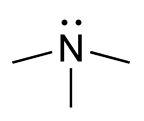
Electron ionization is an ionization method in which energetic electrons interact with solid or gas phase atoms or molecules to produce ions. EI was one of the first ionization techniques developed for mass spectrometry. However, this method is still a popular ionization technique. This technique is considered a hard ionization method, since it uses highly energetic electrons to produce ions. This leads to extensive fragmentation, which can be helpful for structure determination of unknown compounds. EI is the most useful for organic compounds which have a molecular weight below 600 amu. Also, several other thermally stable and volatile compounds in solid, liquid and gas states can be detected with the use of this technique when coupled with various separation methods.

Bad breath, also known as halitosis, is a symptom in which a noticeably unpleasant breath odour is present. It can result in anxiety among those affected. It is also associated with depression and symptoms of obsessive compulsive disorder.
Volatile organic compounds (VOCs) are organic compounds that have a high vapor pressure at room temperature. High vapor pressure correlates with a low boiling point, which relates to the number of the sample's molecules in the surrounding air, a trait known as volatility.

An aroma compound, also known as an odorant, aroma, fragrance or flavoring, is a chemical compound that has a smell or odor. For an individual chemical or class of chemical compounds to impart a smell or fragrance, it must be sufficiently volatile for transmission via the air to the olfactory system in the upper part of the nose. As examples, various fragrant fruits have diverse aroma compounds, particularly strawberries which are commercially cultivated to have appealing aromas, and contain several hundred aroma compounds.

Hepatic encephalopathy (HE) is an altered level of consciousness as a result of liver failure. Its onset may be gradual or sudden. Other symptoms may include movement problems, changes in mood, or changes in personality. In the advanced stages it can result in a coma.

Trimethylamine (TMA) is an organic compound with the formula N(CH3)3. It is a trimethylated derivative of ammonia. TMA is widely used in industry. At higher concentrations it has an ammonia-like odor, and can cause necrosis of mucous membranes on contact. At lower concentrations, it has a "fishy" odor, the odor associated with rotting fish.

Trimethylaminuria (TMAU), also known as fish odor syndrome or fish malodor syndrome, is a rare metabolic disorder that causes a defect in the normal production of an enzyme named flavin-containing monooxygenase 3 (FMO3). When FMO3 is not working correctly or if not enough enzyme is produced, the body loses the ability to properly convert the fishy-smelling chemical trimethylamine (TMA) from precursor compounds in food digestion into trimethylamine oxide (TMAO), through a process called N-oxidation.

Dimethyl sulfide (DMS) or methylthiomethane is an organosulfur compound with the formula (CH3)2S. It is the simplest thioether and has a characteristic disagreeable odor. It is a flammable liquid that boils at 37 °C (99 °F). It is a component of the smell produced from cooking of certain vegetables, notably maize, cabbage, beetroot, and seafoods. It is also an indication of bacterial contamination in malt production and brewing. It is a breakdown product of dimethylsulfoniopropionate (DMSP), and is also produced by the bacterial metabolism of methanethiol.

4-Androstene-3,6,17-trione is a drug or nutritional supplement that may increase the testosterone-estrogen ratio, but has no proven effect on body composition. Its use can be detected in urine.

An electronic nose is an electronic sensing device intended to detect odors or flavors. The expression "electronic sensing" refers to the capability of reproducing human senses using sensor arrays and pattern recognition systems.

Flavin-containing monooxygenase 3 (FMO3), also known as dimethylaniline monooxygenase [N-oxide-forming] 3 and trimethylamine monooxygenase, is a flavoprotein enzyme (EC 1.14.13.148) that in humans is encoded by the FMO3 gene. This enzyme catalyzes the following chemical reaction, among others:

Cirrhosis, also known as liver cirrhosis or hepatic cirrhosis, and end-stage liver disease, is a condition of the liver in which the normal functioning tissue, or parenchyma, is replaced with scar tissue (fibrosis) and regenerative nodules as a result of chronic liver disease. Damage to the liver leads to repair of liver tissue and subsequent formation of scar tissue. Over time, scar tissue and nodules of regenerating hepatocytes can replace the parenchyma, causing increased resistance to blood flow in the liver's capillaries—the hepatic sinusoids—and consequently portal hypertension, as well as impairment in other aspects of liver function. The disease typically develops slowly over months or years.

4'-Methyl-α-pyrrolidinopropiophenone is a stimulant drug and substituted cathinone. It is structurally very similar to α-PPP, with only one added methyl group in the para position on the phenyl ring. 4-MePPP was sold in Germany as a designer drug in the late 1990s and early 2000s, along with a number of other pyrrolidinophenone derivatives. Although it has never achieved the same international popularity as its better-known relations α-PPP and MDPV, 4-MePPP is still sometimes found as an ingredient of grey-market "bath salt" blends such as "NRG-3".

4'-Methoxy-α-pyrrolidinopropiophenone (MOPPP) is a stimulant designer drug of the pyrrolidinophenone class. It has the potential to produce euphoria, an effect shared with other classical stimulants.
A chromatography detector is a device that detects and quantifies separated compounds as they elute from the chromatographic column. These detectors are integral to various chromatographic techniques, such as gas chromatography, liquid chromatography, and high-performance liquid chromatography, and supercritical fluid chromatography among others. The main function of a chromatography detector is to translate the physical or chemical properties of the analyte molecules into measurable signal, typically electrical signal, that can be displayed as a function of time in a graphical presentation, called a chromatograms. Chromatograms can provide valuable information about the composition and concentration of the components in the sample.
Breath gas analysis is a method for gaining information on the clinical state of an individual by monitoring volatile organic compounds (VOCs) present in the exhaled breath. Exhaled breath is naturally produced by the human body through expiration and therefore can be collected in non-invasively and in an unlimited way. VOCs in exhaled breath can represent biomarkers for certain pathologies. Breath gas concentration can then be related to blood concentrations via mathematical modeling as for example in blood alcohol testing. There are various techniques that can be employed to collect and analyze exhaled breath. Research on exhaled breath started many years ago, there is currently limited clinical application of it for disease diagnosis. However, this might change in the near future as currently large implementation studies are starting globally.
Analytical thermal desorption, known within the analytical chemistry community simply as "thermal desorption" (TD), is a technique that concentrates volatile organic compounds (VOCs) in gas streams prior to injection into a gas chromatograph (GC). It can be used to lower the detection limits of GC methods, and can improve chromatographic performance by reducing peak widths.
The volatilome contains all of the volatile metabolites as well as other volatile organic and inorganic compounds that originate from an organism, super-organism, or ecosystem. The atmosphere of a living planet could be regarded as its volatilome. While all volatile metabolites in the volatilome can be thought of as a subset of the metabolome, the volatilome also contains exogenously derived compounds that do not derive from metabolic processes, therefore the volatilome can be regarded as a distinct entity from the metabolome. The volatilome is a component of the 'aura' of molecules and microbes that surrounds all organisms.
Gas chromatography-olfactometry (GC-O) is a technique that integrates the separation of volatile compounds using a gas chromatograph with the detection of odour using an olfactometer. It was first invented and applied in 1964 by Fuller and co-workers. While GC separates volatile compounds from an extract, human olfaction detects the odour activity of each eluting compound. In this olfactometric detection, a human assessor may qualitatively determine whether a compound has odour activity or describe the odour perceived, or quantitatively evaluate the intensity of the odour or the duration of the odour activity. The olfactometric detection of compounds allows the assessment of the relationship between a quantified substance and the human perception of its odour, without instrumental detection limits present in other kinds of detectors. Compound identification still requires use of other detectors, such as mass spectrometry, with analytical standards.
Smell as evidence of disease has been long used, dating back to Hippocrates around 400 years BCE. It is still employed with a focus on volatile organic compounds (VOCs) found in body odor. VOCs are carbon-based molecular groups having a low molecular weight, secreted during cells' metabolic processes. Their profiles may be altered by diseases such as cancer, metabolic disorders, genetic disorders, infections, and among others. Abnormal changes in VOC composition can be identified through equipment such as gas chromatography-mass spectrometry(GC-MS), electronic nose (e-noses), and trained non-human olfaction.













